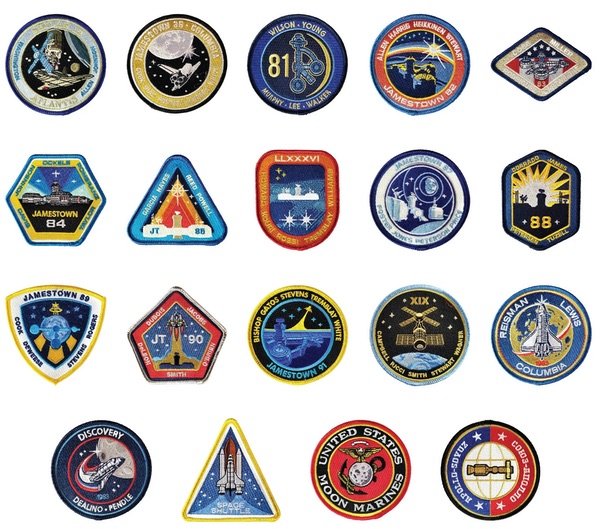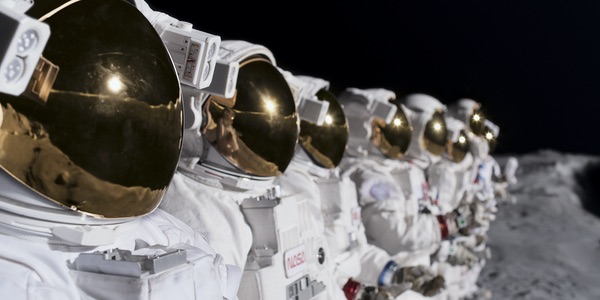It is very cold in space: Season 2 of “For All Mankind”by Dwayne A. Day
|
| One of the show’s greatest attributes was its ability to use its setting to ask questions about American society. By positing what could have been, the show asked why didn’t it happen? |
So often, Hollywood demonstrates only a thin understanding of the subject matter of the shows it produces. Real doctors, lawyers, police officers, theologians, scientists, psychologists, teachers, engineers, and astronauts watch programs about their professions and scoff at how little they get right. TV writers quite often seem to get their knowledge of complex subjects from Wikipedia. But “For All Mankind” is different. It is almost as if the show has dropped its cameras into the time period (the late 1960s and early 1970s in season one, 1983 in season two) and filmed what actually happened, even though it didn’t… but could have.
The show’s strengths go beyond its level of verisimilitude. This is one of the few shows on television that is about something, that has questions to ask and answers to pose and ideas to explore. The show’s second season is mostly successful at doing that, although it stumbles a bit at the finish line.
“For All Mankind” is a fictional depiction of the American space program based upon a series of starting assumptions that are then played out within the larger context of American politics and culture at the time. One of the show’s greatest attributes was its ability to use its setting to ask questions about American society. By positing what could have been, the show asked why didn’t it happen? That approach helps remind us that when we view historical events, we do not assume they were set in stone. Just as people can make decisions today that will affect what happens tomorrow and how we will be viewed by people looking back at our era, people of the past made decisions then that resulted in certain outcomes, but it is a mistake to assume that no other outcomes were possible.
Season one started with a Soviet cosmonaut stepping on the Moon before Neil Armstrong and Buzz Aldrin arrived there, setting the stage for a series of events that changed American history. The writers demonstrated a sophisticated ability to extrapolate from their starting premise—if the Soviets landed first on the Moon, it would have caused a reaction by the Americans, and a reaction by the Soviets. This extended not only to the American space program, where women were introduced to spaceflight a decade earlier than actually happened, but to American politics, where Ted Kennedy avoids the Chappaquiddick scandal and defeats Richard Nixon for the presidency in 1972. The show theorized that the American Apollo program would not come to a halt at Apollo 17, but continue with the establishment of a lunar outpost by the mid-1970s, and greater ambitions beyond. It was an intriguing premise that explored issues such as gender politics and social progress by changing some of the starting conditions. Showing black and female astronauts in space—and on the Moon—in the early 1970s raised the question of why that did not happen. The answer, of course, is that people in NASA and American government chose not to include blacks and women in the space program at that time, they established criteria that excluded women and blacks from participating.
The first season ended in 1974 with an American outpost at the lunar south pole and the kind of space program that most space enthusiasts of the time fantasized about. Season two picks up nine years later. The main characters are still present, although their situations have changed over the years. Ed Baldwin, the commander of the Jamestown station, now flies a desk, and remains married to his wife Karen, although both still remain wounded after the tragic death of their son. Baldwin is still friends with his emotionally troubled co-pilot Gordo Stevens, whose wife Tracy became famous for heroically saving a space mission from disaster. The Jamestown outpost is now significantly bigger, holding over a dozen astronauts serving multi-month tours on the Moon. NASA is flush with money, operating a fleet of space shuttles and even an orbiting Skylab space station. Whereas it sometimes bordered on wish fulfilment, the show also indicated that dreams have a price. In the first season, NASA was forced to partner with the military. A decade later Jamestown is a civilian facility, but NASA’s close cooperation with the military is unsettling to those who work and fly for it.
| One of its strengths is that “For All Mankind” gets the feel of the space program better than just about any other prior television show and even big budget movies like Apollo 13. |
The first new episode premieres on AppleTV+ on February 19, with subsequent episodes debuting weekly thereafter. AppleTV+ made the entire second season available to critics under an embargo. “For All Mankind” is a drama setting its characters against the backdrop, and occasionally as participants, of the Cold War. The show treats its characters with respect, including those not directly tied to the main drama. The first season often took the space program’s personality tropes—the stoic commander, the supportive wife—and demonstrated that they are more than that, with strengths and flaws that can be both maddening and inspiring. Even if they are unwilling to confront their own flaws, they often are at least aware of them. These are people who sometimes try a bit too hard to keep in control, and when they lose that control, the cracks can shatter them.
As the season two trailers have shown, political tensions on Earth—the Cold War struggle and President Reagan’s defense buildup—have spread into outer space by 1983, although viewers should beware of jumping to conclusions before watching the show. Reagan, for instance, stays mostly in the background but is never the gun-toting cowboy he is sometimes portrayed as in movies and television.
For the most part the show depicts a reasonably realistic world and sequence of events, given the assumption that NASA was provided with a far bigger budget in the post-Apollo era. The laws of physics are bent much more than they are in Amazon Prime’s “The Expanse,” and later episodes are likely to lead so some hair-pulling by viewers who long for a TV show that accurately depicts travel in space and does not toss aside orbital mechanics for a cool plot point. But “For All Mankind” is still science fiction, not science fact, and the needs of storytelling outweigh the laws of physics in shows like this. (See: “In the paler moonlight: the future’s past in ‘For All Mankind,” The Space Review, October 12, 2020, and, “Wasn’t the future wonderful? For All Mankind and the space program we didn’t get,” The Space Review, March 9, 2020.)
 A set of patches released to coincide with the second season offers some hints about what may happen. (credit: Icon Heroes) |
One of its strengths is that “For All Mankind” gets the feel of the space program better than just about any other prior television show and even big budget movies like Apollo 13. It gets the details and the nuances right, with clever touches like the popular astronaut bar located next to the used book store, which will be familiar to those who lived and worked near Johnson Space Center in the 1980s. When we are reintroduced to him, Gordo Stevens is doing the rubber chicken circuit, appearing at Rotary Club meetings explaining how astronauts go to the bathroom in space, just like some of the Apollo-era veterans who gave speeches and sold autographs when they couldn’t make product endorsements. New astronaut candidates all live in fear of never getting a flight assignment. Not everybody is happy with NASA becoming an arm of the military. And characters bemoan the fact that NASA’s lunar base is not a stepping stone to Mars, but a quagmire making Mars impossible. Space is still at times very hostile, and deadly, and spaceflight can be bureaucratic.
Rather than alternative history, the show is perhaps better described as parallel history. Although there are differences—John Lennon survives an assassin’s bullet and becomes a peace advocate, the NASA administrator works out of Houston rather than Washington—this is still mostly the world that existed at the time. The first season covered a bigger timespan—roughly early 1969 to mid-1974—but season two covers a few months in 1983, one of the tensest years of the Cold War other than 1962’s Cuban Missile Crisis. Central America was a focus of superpower struggle, and both the United States and Soviet Union were making lethal blunders that year that raised the risk of global war.
| One character even quotes Captain Kirk—yes, Star Trek exists in this parallel history, and inspires the people at NASA. |
Unlike other entertainment set in the 1980s, the show doesn’t wallow in ’80s nostalgia for its own sake. “For All Mankind” isn’t set in 1983 because of the fashion or the music (neither of which make much of an appearance), but the politics and the social issues. Whereas the first season focused on the introduction of women into the space program, the second season deals more with issues involving a black astronaut who justifiably feels relegated to token status, and a closeted gay woman confronting the reality that if she doesn’t lie about who she is and deny herself what, and who, she wants, her promising career will end.
But it is Cold War brinksmanship that drives the season, and at least at first, what happens at Jamestown is impacted by the larger geopolitical conflicts back on Earth, not a cause of them. Producer Ron Moore has said that he wanted to make a show that depicted how we could get from the world of today to the idealistic world of Star Trek, where people explore the stars and seek out new life and new civilizations, and season two, particularly the last two episodes, provides hints of how spaceflight can inspire and change the world. One character even quotes Captain Kirk—yes, Star Trek exists in this parallel history, and inspires the people at NASA. For most of the season the characters and the space program are caught up in the larger issues, but by the climax, their actions and their choices become deciding factors in whether or not the Cold War turns hot. Although the final episode is longer than the rest, it packs a bit too much plot for its own good, stumbling over multiple interacting storylines but ultimately ending in a surprising place. The show has been renewed for another season, and it will be fascinating to see where it boldly goes from here.
Note: we are temporarily moderating all comments submitted to deal with a surge in spam.
